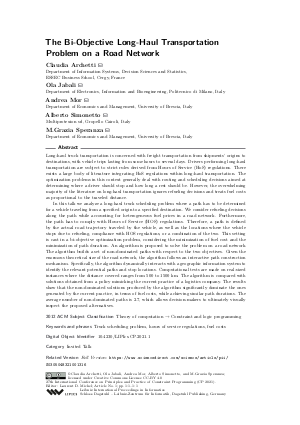The Bi-Objective Long-Haul Transportation Problem on a Road Network (Invited Talk)
Authors Claudia Archetti, Ola Jabali, Andrea Mor, Alberto Simonetto, M.Grazia Speranza
-
Part of:
Volume:
27th International Conference on Principles and Practice of Constraint Programming (CP 2021)
Part of: Series: Leibniz International Proceedings in Informatics (LIPIcs)
Part of: Conference: International Conference on Principles and Practice of Constraint Programming (CP) - License:
 Creative Commons Attribution 4.0 International license
Creative Commons Attribution 4.0 International license
- Publication Date: 2021-10-15
File

PDF
LIPIcs.CP.2021.1.pdf
- Filesize: 297 kB
- 1 pages
Document Identifiers
Related Versions
Subject Classification
ACM Subject Classification
- Theory of computation → Constraint and logic programming
Keywords
- Truck scheduling problem
- hours of service regulations
- fuel costs
Metrics
- Access Statistics
-
Total Accesses (updated on a weekly basis)
0PDF Downloads0Metadata Views
Abstract
Long-haul truck transportation is concerned with freight transportation from shipments' origins to destinations, with vehicle trips lasting from some hours to several days. Drivers performing long-haul transportation are subject to strict rules derived from Hours of Service (HoS) regulations. There exists a large body of literature integrating HoS regulations within long-haul transportation. The optimization problems in this context generally deal with routing and scheduling decisions aimed at determining where a driver should stop and how long a rest should be. However, the overwhelming majority of the literature on long-haul transportation ignores refueling decisions and treats fuel costs as proportional to the traveled distance. In this talk we analyze a long-haul truck scheduling problem where a path has to be determined for a vehicle traveling from a specified origin to a specified destination. We consider refueling decisions along the path while accounting for heterogeneous fuel prices in a road network. Furthermore, the path has to comply with Hours of Service (HOS) regulations. Therefore, a path is defined by the actual road trajectory traveled by the vehicle, as well as the locations where the vehicle stops due to refueling, compliance with HOS regulations, or a combination of the two. This setting is cast in a bi-objective optimization problem, considering the minimization of fuel cost and the minimization of path duration. An algorithm is proposed to solve the problem on a road network. The algorithm builds a set of non-dominated paths with respect to the two objectives. Given the enormous theoretical size of the road network, the algorithm follows an interactive path construction mechanism. Specifically, the algorithm dynamically interacts with a geographic information system to identify the relevant potential paths and stop locations. Computational tests are made on real-sized instances where the distance covered ranges from 500 to 1500 km. The algorithm is compared with solutions obtained from a policy mimicking the current practice of a logistics company. The results show that the non-dominated solutions produced by the algorithm significantly dominate the ones generated by the current practice, in terms of fuel costs, while achieving similar path durations. The average number of non-dominated paths is 2.7, which allows decision-makers to ultimately visually inspect the proposed alternatives.
Cite As Get BibTex
Claudia Archetti, Ola Jabali, Andrea Mor, Alberto Simonetto, and M.Grazia Speranza. The Bi-Objective Long-Haul Transportation Problem on a Road Network (Invited Talk). In 27th International Conference on Principles and Practice of Constraint Programming (CP 2021). Leibniz International Proceedings in Informatics (LIPIcs), Volume 210, p. 1:1, Schloss Dagstuhl – Leibniz-Zentrum für Informatik (2021)
https://doi.org/10.4230/LIPIcs.CP.2021.1
BibTex
@InProceedings{archetti_et_al:LIPIcs.CP.2021.1,
author = {Archetti, Claudia and Jabali, Ola and Mor, Andrea and Simonetto, Alberto and Speranza, M.Grazia},
title = {{The Bi-Objective Long-Haul Transportation Problem on a Road Network}},
booktitle = {27th International Conference on Principles and Practice of Constraint Programming (CP 2021)},
pages = {1:1--1:1},
series = {Leibniz International Proceedings in Informatics (LIPIcs)},
ISBN = {978-3-95977-211-2},
ISSN = {1868-8969},
year = {2021},
volume = {210},
editor = {Michel, Laurent D.},
publisher = {Schloss Dagstuhl -- Leibniz-Zentrum f{\"u}r Informatik},
address = {Dagstuhl, Germany},
URL = {https://drops.dagstuhl.de/entities/document/10.4230/LIPIcs.CP.2021.1},
URN = {urn:nbn:de:0030-drops-152926},
doi = {10.4230/LIPIcs.CP.2021.1},
annote = {Keywords: Truck scheduling problem, hours of service regulations, fuel costs}
}
Author Details
- Department of Information Systems, Decision Sciences and Statistics, ESSEC Business School, Cergy, France
